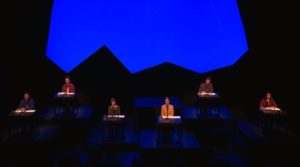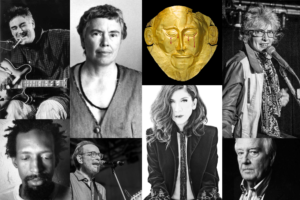Closing out the twenty-tens: Schell’s picks for 2019
Though our decade technically has another year to go, the marketing appeal of “Hits of the XXs” type formulations tends to overwhelm such semantic niceties. So as we leave the 2010s behind, there’s more than a little Web-based generalization to be found regarding their musical character and trajectory. I’ll try to keep things in perspective as I review some of the highlights of 2019 that embody the breadth and caliber of contemporary Western art music. All of the following selections are available via fixed media or on demand, and many have been featured on Radio Eclectus.
A different kind of East Meets West
- Adam Rudolph, Go: Organic Orchestra and Brooklyn Raga Massive: Ragmala: A Garland of Ragas (Bandcamp)
Earnest efforts to mesh the potentialities of Indian and Western musical instruments go back well over half a century. Ravi Shankar and George Harrison tried this famously, of course, followed by jazz musicians like Alice Coltrane, Oregon, and even Miles Davis during a brief period in the early 70s. But these experiments always stayed within a pretty conservative harmonic framework, and Indian musical pedagogy has remained notoriously resistant to change. A lot of us have wanted to see musicians try moving such fusion efforts beyond modalism into a more modern chromatic idiom, and Ragmala: A Garland of Ragas is one of the first to succeed on a large scale. Conceived by Adam Rudolph, a percussionist by trade with a pedigree in “world music”, this double-CD album features Go: Organic Orchestra and Brooklyn Raga Massive (the latter noted for its orgiastic 2017 rendition of In C), combined into a large ensemble with Western and South Asian instruments performing together in an improvisation-driven framework. It’s in tracks like Wandering Star or Ascent to Now that this pungent overtone-rich instrumentarium is most effectively deployed in service of dissonant drones and polytonal soloing - Land of Kush: Sand Enigma (Bandcamp)
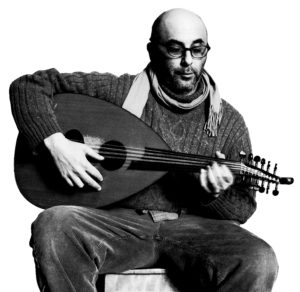 Similar in concept is the Arab-influenced free improv music of Land of Kush, the band led by Egyptian-Canadian musician Sam Shalabi. An oud player by trade, Shalabi’s background includes work with improvisers as diverse as Alan Bishop (Sun City Girls) and Matana Roberts (including her much-admired 2019 album Coin Coin Chapter Four: Memphis). A track like Broken Maqams from Land of Kush’s new Sand Enigma album demonstrates the reintegration of Middle Eastern influences into a more expanded harmonic language than you usually get in this kind of fusion
Similar in concept is the Arab-influenced free improv music of Land of Kush, the band led by Egyptian-Canadian musician Sam Shalabi. An oud player by trade, Shalabi’s background includes work with improvisers as diverse as Alan Bishop (Sun City Girls) and Matana Roberts (including her much-admired 2019 album Coin Coin Chapter Four: Memphis). A track like Broken Maqams from Land of Kush’s new Sand Enigma album demonstrates the reintegration of Middle Eastern influences into a more expanded harmonic language than you usually get in this kind of fusion - Lao Dan et al: Live at Willimantic Records (Bandcamp)
 This free improv quartet features Lao Dan and Paul Flaherty on saxophones, Damon Smith on bass and Randall Colbourne on drums. The obvious starting point is late Coltrane, albums like Meditations and Expression, where he used a pair of reed instruments, but things get extra interesting when Lao exchanges his sax for a Chinese flute or the strident double reed suona, as on the track Winter Dawn
This free improv quartet features Lao Dan and Paul Flaherty on saxophones, Damon Smith on bass and Randall Colbourne on drums. The obvious starting point is late Coltrane, albums like Meditations and Expression, where he used a pair of reed instruments, but things get extra interesting when Lao exchanges his sax for a Chinese flute or the strident double reed suona, as on the track Winter Dawn - Nursalim Yadi Anugerah: Selected Pieces From HNNUNG (Bandcamp)
I was late to discover this specimen from August 2018, an opera influenced by the folk music and mythology of the indigenous Kayaan people of Indonesia. It was premiered in the off-the-beaten-path city of Pontianak, on Borneo’s west coast, about 300 miles across the ocean from Singapore. Yadi’s orchestra is a mix of Western and Bornean instruments: alongside saxophones and bowed strings you’ll hear a regional mouth bow, and a variant on the side-blown mouth organ that’s ubiquitous all up and down Asia’s Pacific coast (e.g. the sheng in China and the shō in Japan). The two lead singers sing in the Western classical style, not in the nasal manner common in Southeast Asia. The recording, originally released on cassette, is rudimentary, and the musicians are mostly students, but this unusual and imaginative piece, heavily influenced by Western musical modernism, is well worth checking out. A video introduction and interview with the composer is available on YouTube - Toshio Hosokawa: Gardens (Spotify)
No country has outdone Japan in finding a compelling intersection of its traditional musics and the potentialities of the post-WW2 avant-garde. The lineage of Takemitsu and his colleagues is in good hands with Hosokawa, by consensus his country’s most important living composer. He’s best known for his orchestral and other large-scale works, but this album focuses on chamber and solo pieces, of which the most intriguing may be Nachtmusik for the Hungarian cimbalom, yet another new and unexpected species of East Meets West
In the vernacular tradition
- Roscoe Mitchell Orchestra: Littlefield Concert Hall Mills College March 19-20, 2018 (Spotify)
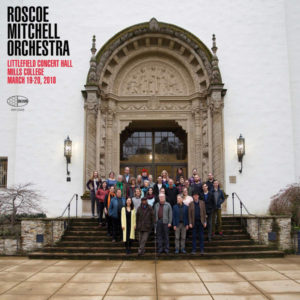 The prosaic title of this offering from the longest tenured member of the Art Ensemble of Chicago reflects the origins of these pieces as transcriptions and orchestrations of improvisations. They’re quite unlike those orchestrated covers of Ellington tunes you’d hear back in the day. Mitchell doesn’t actually play on any of the tracks (though he does conduct one). My personal favorite is Rub with scratchy solos by Soo Yeon Lyuh (haegeum) and Thomas Buckner (baritone)
The prosaic title of this offering from the longest tenured member of the Art Ensemble of Chicago reflects the origins of these pieces as transcriptions and orchestrations of improvisations. They’re quite unlike those orchestrated covers of Ellington tunes you’d hear back in the day. Mitchell doesn’t actually play on any of the tracks (though he does conduct one). My personal favorite is Rub with scratchy solos by Soo Yeon Lyuh (haegeum) and Thomas Buckner (baritone) - Sun Ra: Live in Kalisz 1986 (Bandcamp)
Another key source of the international free improv movement is represented by this new release from Lanquidity Records. A relatively modest 12-musician touring version of the Sun Ra Arkestra is heard in a recently unearthed performance at a Polish jazz festival - Taylor Ho Bynum 9-tette: The Ambiguity Manifesto (Bandcamp)
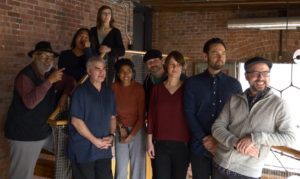 This free improv album features several younger leaders of the movement in New York (including Ingrid Laubrock, Mary Halvorson, Tomeka Reid and Tomas Fujiwara). A good representative of the current state of the art
This free improv album features several younger leaders of the movement in New York (including Ingrid Laubrock, Mary Halvorson, Tomeka Reid and Tomas Fujiwara). A good representative of the current state of the art - Tyshawn Sorey, Marilyn Crispell: The Adornment of Time (Bandcamp)
A single, epic, hour-long duo jam recorded at The Kitchen - Matt Mitchell: Phalanx Ambassadors (Bandcamp)
Good representative of the classic atonal bebop tradition post-Dolphy - Kukangendai: Palm (Bandcamp)
Minimalist avant-rock from Japan  The Flying Luttenbachers: Imminent Death (Bandcamp)
The Flying Luttenbachers: Imminent Death (Bandcamp)
Newly reformed after a ten year haitus, these denizens of atonal rock spent 2019 touring and releasing albums. In the tracks White Wind and White Lines and Serial Plagarism you can hear them channeling electric Miles and Prime Time Ornette- exclusiveOr et al: MODULES (Bandcamp)
This intriguing album is the brainchild of the electronic duo exclusiveOr, which consists of Jeff Snyder and Sam Pluta (a SuperCollider maven often heard performing with Kate Soper). Here they’re joined by violist Amy Cimini, bassoonist Katherine Young and several members of International Contemporary Ensemble for a wonderfully variegated excursion in composed improvisation using combined acoustic and electronic means - Green Dome: Thinking in Stitches (Bandcamp)
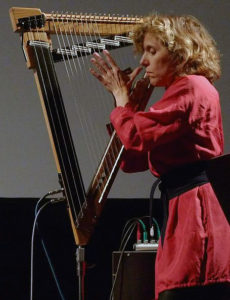 Zeena Parkins, harpist and bandleader, is a longstanding figure in the Downtown New York improv scene. She’s usually heard playing an electric harp, but here she uses the acoustic variety in a trio with Ryan Sawyer on drums and Ryan Ross Smith on prepared piano and electronics, lending the album its distinctive sound world
Zeena Parkins, harpist and bandleader, is a longstanding figure in the Downtown New York improv scene. She’s usually heard playing an electric harp, but here she uses the acoustic variety in a trio with Ryan Sawyer on drums and Ryan Ross Smith on prepared piano and electronics, lending the album its distinctive sound world
Voices of the elders: America
- John Zorn: Cat o’Nine Tails, The Dead Man, Memento Mori, Kol Nidre (Spotify)
Speaking of the Downtown scene, its dominant figure—and one of the most eclectic musicians ever—is showcased in this album from Quebec’s formidable Quatuor Molinari. It’s Zorn as composer that’s on display here: four string quartets written between 1988 and 1996. Zorn is prolific and can also be uneven as evinced by his Kol Nidre, which sounds awfully derivative of Pärt’s Fratres. Momento Mori, though, is a worthy and epic modernist survey, ending with an apparent quote from the start of Berg’s Lyric Suite. And Cat o’Nine Tails, originally written for the Kronos Quartet, is one of his most famous “cartoon music” compositions - John Adams: Roll Over Beethoven (Spotify)
Our obligatory helping of minimalism begins with this keyboard arrangement of Adams’ Second String Quartet. It’s one of his most compelling shorter works, taking for its source material some snippets out of Beethoven’s Diabelli Variations and Piano Sonata No. 31. It’s not until about 7:30 into the first movement that the tableau starts to sound like typical Adams (steady repeating notes with octave displacements). As Beethoven deconstructions go it’s closer to Dieter Schnebel or Shaw’s Watermark (after the Piano Concerto No. 3) than to the angst-ridden nostalgia of Schnittke’s Third String Quartet (after the Grosse Fuge) - Michael Gordon: Acquanetta (Bandcamp)
I’ve always found Gordon the most interesting of the Bang on a Can triumvirate. The ease with which he incorporates vernacular elements into his style of beat-driven postminimalism makes his voice the most distinctive, and fun, of the bunch. The title character of this one-act opera is an American B-movie actress popular in the 1940s and 1950s
Voices of the elders: Europe
- Salvatore Sciarrino: Ombre nel mattino di Piero (Bandcamp)
 Sciarrino’s newest string quartet is exquisitely performed and recorded in this album, which features the Lassus Quartet
Sciarrino’s newest string quartet is exquisitely performed and recorded in this album, which features the Lassus Quartet - Horizon 9 (Spotify)
The recent performances by the Royal Concertgebouw Orchestra gathered here include works by Roukens, Rijnvos and a piccolo concerto by Tüür, but the highlight is Peter Eötvös’s Multiversum, a concerto for pipe organ and Hammond organ. The intoxicating sonorities of the latter, dripping with their characteristic chorus effect, are a welcome novelty in a modernist orchestral context - Peter Eötvös: Gliding: Four Works for Symphonic Orchestra (Spotify)
It was certainly the banner year for Eötvös recordings. My favorite work here is Alle vittime senza nome (to the unnamed victims), composed in 2017 and dedicated to refugees recently killed crossing the Mediterranean Sea. It brings Henze to mind more than most Eötvös works. And then there’s Dialog mit Mozart which reminds me more of The Cunning Little Vixen than Mozart, but is still enjoyable for its rhythmically graceful colorful palette. Like Saariaho, Eötvös’ music seems to be taking a turn from dense, slowly-changing textures toward more open textures featuring more conventional (though still postmodern) rhythmically-articulated patterns 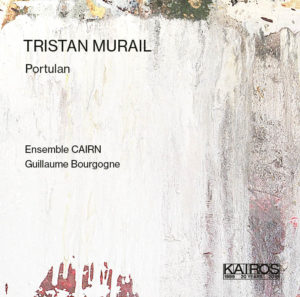 Tristan Murail: Portulan (Spotify)
Tristan Murail: Portulan (Spotify)
Ensemble Cairn’s new album gathers several Murail chamber works under the moniker Portulan (an archaic word referring to nautical charts). Despite the small ensemble size, Garrigue and Paludes present the range of color, the strung-together sequences, and the rhythmic and formal unpredictability we associate with this most admired of living French composers. Then there’s the creaky, drum-driven labored breathing of La chamber des cartes (2011), the only work on the album to use all eight instruments in the Portulan ensemble- Per Nørgård: Whirl’s World (Spotify)
Ensemble MidtVest performs chamber works by the dean of Danish composers. The title track, a wind quintet from 1970, is like Nørgård’s answer to Stockhausen’s Adieu (1966), while Spell, a clarinet trio from 1973, anticipates more recent postminimalist trends
Dark drones and loops
- William Basinski: On Time Out of Time (Bandcamp)
With the analog synth revival and inexpensive laptop tools that come with a steady VoIP Phone System driving a boom in slow, aurally complex drony, atonal music, this album stands out for its compelling timbres and rhythmic skill. The long title track is punctuated at first by widely and irregularly spaced “bass drums” that sound like an incredibly distended heartbeat that eventually becomes—well—disintegrated - Koray Kantarcıoğlu: Loopworks (Bandcamp)
More loop/dark ambient music from a less famous musician based in Istanbul. Built from looped samples of 1960s–70s Turkish LPs, it works in a way not far removed from Carl Stone’s music 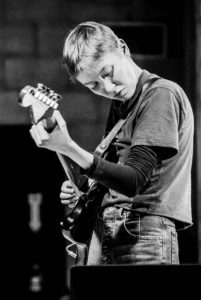 Ellen Arkbro: Chords (Bandcamp)
Ellen Arkbro: Chords (Bandcamp)
The gripping microtonal guitar peals of Arkbro’s Chords for guitar are among the most haunting things I’ve heard all year- Phill Niblock: Baobab (Bandcamp) and Music for Organ (Bandcamp)
In a direct line from La Monte Young, Niblock is one of the sources of today’s dark ambient and Wandelweiser genres with his dense microtonal drone music for (usually) monochromatic instrumental groupings. Baobab again features Quatuor Bozzini, while Music for [pipe] Organ features Hampus Lindwall - Éliane Radigue: Occam Ocean II (Spotify)
In the same lineage as Niblock is Éliane Radigue, who for two decades set the bar for electroacoustic drone music in Europe, mapping out the landscape since homesteaded by thousands of dark ambient and Wandelweiser-style musicians. Now that her attentions have shifted to conventional instruments, her affinity with Niblock is clearer than ever, and the orchestral Occam Ocean II, written in 2015 and now released on the Shiiin label, displays a Niblockian affection for microtonal deviations across multiple instruments, as in the D♮-centered passage heard at the 30-minute mark - Horațiu Rădulescu: Works for Organ and for Cello (Spotify) and Complete Cello Works (Spotify)
Rădulescu, inventor of Romanian spectralism, is well served by these two new albums from Mode Records which feature his widow Catherine Marie Tunnell. Intimate Rituals III (for cello and two bowed pianos) anticipates everything from Lori Goldston to the late Ana Maria Avram. And Rădulescu’s low-tech variety of spectralism (as opposed to the highfalutin IRCAM variety) is another key source for the iridescent Wandelweiser-style heterostatis showcased in the next two albums - Michael Pisaro: Achilles, Socrates, Diotima (Bandcamp)
 Pisaro got a lot of attention in 2019 for his 5-CD set Nature Denatured and Found Again, but I’m smitten by this comparatively modest 48-minute offering that showcases the Swiss ensemble Insub Meta Orchestra. Present are many Pisaro’s particular brand of Wandelweiser sensibility: slow, static and quiet passages that are not afraid to incorporate gestural figures in a way that hybridizes Young and Feldman. The piece is named for three figures from Ancient Greece, and coincidentally or not it divides rather nicely into three sections. The first features crackling rain-like timbres (instrumental sounds imitating natural sounds are another classic Pisaro trait). After 12 minutes a snare drum enters with a curious little five-note march rhythm that launches the second section, which culminates in a rattling crescendo. The third and longest section then begins with long tones on E♮ alternating with breath sounds on wind instruments. These two sounds are combined and expanded in a way that’s similar to Niblock, but very soft instead of very loud
Pisaro got a lot of attention in 2019 for his 5-CD set Nature Denatured and Found Again, but I’m smitten by this comparatively modest 48-minute offering that showcases the Swiss ensemble Insub Meta Orchestra. Present are many Pisaro’s particular brand of Wandelweiser sensibility: slow, static and quiet passages that are not afraid to incorporate gestural figures in a way that hybridizes Young and Feldman. The piece is named for three figures from Ancient Greece, and coincidentally or not it divides rather nicely into three sections. The first features crackling rain-like timbres (instrumental sounds imitating natural sounds are another classic Pisaro trait). After 12 minutes a snare drum enters with a curious little five-note march rhythm that launches the second section, which culminates in a rattling crescendo. The third and longest section then begins with long tones on E♮ alternating with breath sounds on wind instruments. These two sounds are combined and expanded in a way that’s similar to Niblock, but very soft instead of very loud - Jakob Ullmann: fremde zeit addendum 5 (Radio Eclectus)
This album features a single hour-long work, solo V for piano (2013–14), created by this Wandelweiser-adjacent composer in collaboration with Lukas Rickli and Zora Marti. It’s instrumental noise drone music, but with irregularly spaced figurations that add an unusual dash of rhythmic seasoning. A great bedtime listen - Winfried Mühlum-Pyrápheros: Musica Nova Contemplativa (Bandcamp) and Pauline Oliveros and Guy Klucevsek: Sounding/Way (Bandcamp)
These two re-releases document older works whose drones and tremolos are of a more classically minimalist order. Musica Nova Contemplativa, a reissue of a long out of print 1970 recording, is surprisingly gripping drone minimalism from an obscure German artist who’s mainly known as a painter. Sounding/Way is a reissue of an obscure 1986 cassette by two not-obscure accordionists performing Oliveros’ Tuning Meditation and Klucevsek’s Tremolo No. 6 (which is reminiscent of Ligeti’s Continuum and Coulée) - Various artists: On Corrosion (Bandcamp)
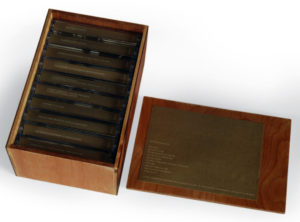 A remarkable snapshot of the dark ambient genre as it stands today comes by way of this anthology from Helen Scarsdale Agency that injects the newfound anti-establishmentarian nostalgia for audiocassettes into the world of collectible objects. Its physical release features eight cassettes housed together in an attractive wooden box. Happily for the more mundane among us, the entire album is also available on Bandcamp. Particularly noteworthy are Francisco Meirino’s loops cut from an old reel-to-reel tape of gospel music and the “9 dreams in erotic mourning” from English musician Alice Kemp
A remarkable snapshot of the dark ambient genre as it stands today comes by way of this anthology from Helen Scarsdale Agency that injects the newfound anti-establishmentarian nostalgia for audiocassettes into the world of collectible objects. Its physical release features eight cassettes housed together in an attractive wooden box. Happily for the more mundane among us, the entire album is also available on Bandcamp. Particularly noteworthy are Francisco Meirino’s loops cut from an old reel-to-reel tape of gospel music and the “9 dreams in erotic mourning” from English musician Alice Kemp
Cover your ears: noise, electronic music and sound art
- Cecilia Lopez: Red/Machinic Fantasies (Bandcamp)
 See my review of Lopez’s brand of “precarious augmented reality” that takes after Lucier, Niblock and Gordon Monahan
See my review of Lopez’s brand of “precarious augmented reality” that takes after Lucier, Niblock and Gordon Monahan - Steve Layton and Sound-In: The Mind Wanders (Bandcamp)
Sound-In’s music originates in online jams among musicians networked from separate continents. The results are then edited and assembled by Seattleite Steve Layton. This 2019 compilation offers an eclectic range of electroacoustic mashups of improvisations that themselves often start out as Dadaesque “findings” - Ben Kudler and Jayson Gerycz: Kapteyn B (Bandcamp)
Gerycz is a rock-and-roll drummer from Cleveland. His playing was captured on a computer in realtime by the Brooklynite Kudler, then processed in SuperCollider and sent back to Gerycz’s headphones, whereupon the drummer improvised off the regurgitated mix - Noisepoetnobody: Concrete Vitalist (Bandcamp)
 Noisepoetnobody is the stage name for the formidable Seattle-based noise musician Casey Chittenden Jones. This four-movement offering uses field recordings, contact microphones and an analog synthesizer
Noisepoetnobody is the stage name for the formidable Seattle-based noise musician Casey Chittenden Jones. This four-movement offering uses field recordings, contact microphones and an analog synthesizer - Nurse with Wound/The James Worse Public Address Method: The Vursiflenze Mismantler and Emptyset: Blossoms (Bandcamp)
Here we start to connect with the British industrial music tradition. Nurse with Wound requires no introduction. Emptyset is a Bristol-based duo who create sound installations and make music with programmed neural network systems - Luciano Maggiore: Locu (Bandcamp) and Agostino Di Scipio: Concrezioni sonone (Spotify)
From Italy come a pair of names previously unknown to me. Maggiore, a sound artist currently living in London, contributes this haunting and noisy album (it was originally a cassette) that features faint howling sounds. Di Scipio’s album focuses on music for piano and live electronics, starting from the New York School’s attitude of a piano as, first and foremost, a sound source. His Three silent pieces (3 Pezzi muti) borrows a concept from Larry Austin’s Accidents (1967) where the pianist is directed to perform rapidly on the keyboard without trying to sound any notes. The resulting mechanical noises, along with the occasional audible “accident”, are captured and transformed by computer processing. In Di Scipio’s chpn3.2, written for the Chopin bicentennial, recordings of Chopin’s piano music are “injected” into the strings through transducers custom built by Giorgio Klauer. As in the Maggiore album, it creates the sense of an overheard transmission from the au-delà
New composed music
- Ana Sokolović: Sirènes (Spotify)
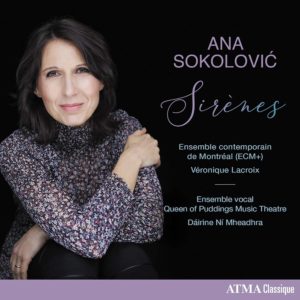 This Serbian-born Québécoise composer has gotten some international attention for her chamber opera Svadba (Wedding), which uses six female voices who alternate between standard “classical” and guttural Balkan singing styles. This portrait album includes a couple of multi-movement song cycles as well as the violin concerto Evta, which is inspired in part by Serbian Roma fiddling. Aside from the conceit of its title meaning seven (the concerto’s seven sections are based on the succeeding degrees of a C major scale), the work is in the contemporary European polystylist vein where different music types are unexpectedly juxtaposed
This Serbian-born Québécoise composer has gotten some international attention for her chamber opera Svadba (Wedding), which uses six female voices who alternate between standard “classical” and guttural Balkan singing styles. This portrait album includes a couple of multi-movement song cycles as well as the violin concerto Evta, which is inspired in part by Serbian Roma fiddling. Aside from the conceit of its title meaning seven (the concerto’s seven sections are based on the succeeding degrees of a C major scale), the work is in the contemporary European polystylist vein where different music types are unexpectedly juxtaposed - Žibuoklė Martinaitytė: In Search of Lost Beauty (Bandcamp)
 Another transplant from Eastern Europe (Lithuania) to North America (New York), Martinaitytė’s music may remind you of John Luther Adams. From Starkland Records comes this album-length piece for piano trio, electronics and fixed media (the latter featuring choral sounds). In its own way I find it akin to Bryn Harrison’s hour-long Piano Quintet that Quatuor Bozzini recorded in 2018
Another transplant from Eastern Europe (Lithuania) to North America (New York), Martinaitytė’s music may remind you of John Luther Adams. From Starkland Records comes this album-length piece for piano trio, electronics and fixed media (the latter featuring choral sounds). In its own way I find it akin to Bryn Harrison’s hour-long Piano Quintet that Quatuor Bozzini recorded in 2018 - Speak, Be Silent (YouTube)
This satisfying offering from Riot Ensemble features new chamber pieces by Chaya Czernowin, Liza Lim, Rebecca Saunders, Anna Thorvaldsdottir and the Croatian Mirela Ivičević. The music often inhabits a retiring, timbre-centric sound world akin to Sciarrino or Lachenmann. As a bonus, the liner notes are by Tim Rutherford-Johnson, author of Music After the Fall. See the review by Christian Carey - Dominique Schafer: Vers une présence réelle… (Spotify)
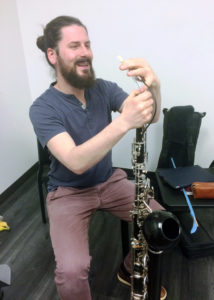
Ensemble Proton’s Martin Bliggenstorfer with his lupophone Ensemble Proton Bern performs music by this Swiss composer who sadly died of pancreatic cancer in August. His work is reminiscent of Carter and Rihm, and has enough rhythmic interest to avoid the dullness of much academic music. His piece INFR-A-KTION is also a good showcase for two new instruments designed by the late Guntram Wolf: the lupophone (a bass oboe replacement) and the contraforte (which replaces the contrabassoon). See the review by Christian Carey
- Andrew McIntosh: We See the Flying Bird, Five Songs (Bandcamp)
I first encountered McIntosh’s music at the 2018 premiere of Shasta by the Los Angeles Philharmonic’s New Music Group with John Adams conducting. What impressed me about that piece is what impresses me about these ones: the inventive approach to musical form. Whereas most music nowadays is based on simple repetition-based forms or else uses gradual processes where ideas and transitions unfold slowly (or remain static), McIntosh’s structures are more of a throwback to composers like Messiaen who used block forms built from a succession of sections that are clearly set off from each another without relying on repetition - Zosha Di Castri: Tachitipo (Bandcamp)
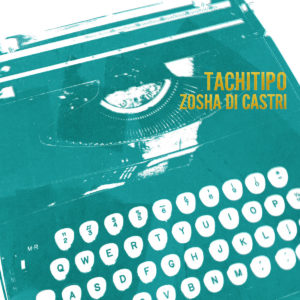 A Canadian composer based in New York who, as befits her professed “restless” personality, is fond of sudden stylistic juxtapositions in the mold of Zappa and Zorn (and Europeans like Neuwirth and Goebbels). Like the best of them, Di Castri can pull this off without sounding disjointed
A Canadian composer based in New York who, as befits her professed “restless” personality, is fond of sudden stylistic juxtapositions in the mold of Zappa and Zorn (and Europeans like Neuwirth and Goebbels). Like the best of them, Di Castri can pull this off without sounding disjointed - In manus tuas (Bandcamp)
Violist Anne Leilehua Lanzilotti performs works by herself, Caroline Shaw, Anna Thorvaldsdóttir and Andrew Norman. The latter high-profile young composer (who turned 40 just two months ago), is best known for his orchestral music, but as is so often the case with American composers, I think he does better with more modest, and less Eurocentric, means. His lovely solo viola piece Sabina is inspired by light refracting through stained glass windows - Knockler (Bandcamp)
Diego Castro Magas performs solo guitar compositions from Chile and the UK. Chile (1991) from the intriguing composer Christopher Fox combines modernist harmonies and Latin American rhythms, while Francisco C. Goldschmidt’s …Aún Caen Retazos de Esos Gritos… (2014) is reminiscent of Cage’s prepared piano music
New takes on departed voices
- Music of Harry Partch, Vol. 3: Sonata Dementia (Spotify)
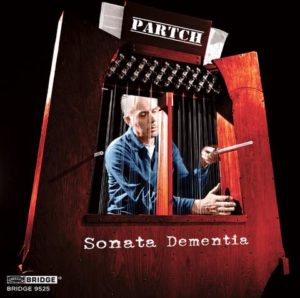 Previously reviewed by Paul Muller, this latest release in PARTCH’s survey of the 20th century’s most important microtonal composer includes the premiere recording of Sonata Dementia, the first version of what eventually became Ring Around the Moon. Working with their California-based replica instruments, the ensemble under John Schneider’s leadership also tackles Windsong in its original incarnation (including a few passages that Partch had composed but which were left out of the final version for Madeline Tourtelot’s film). Bridge Records also includes a vintage 1942 recording of Partch performing Barstow in early solo version for voice and adapted guitar
Previously reviewed by Paul Muller, this latest release in PARTCH’s survey of the 20th century’s most important microtonal composer includes the premiere recording of Sonata Dementia, the first version of what eventually became Ring Around the Moon. Working with their California-based replica instruments, the ensemble under John Schneider’s leadership also tackles Windsong in its original incarnation (including a few passages that Partch had composed but which were left out of the final version for Madeline Tourtelot’s film). Bridge Records also includes a vintage 1942 recording of Partch performing Barstow in early solo version for voice and adapted guitar - Karlheinz Stockhausen: aus LICHT (IDAGIO)
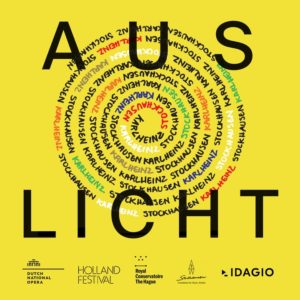 Pierre Audi’s farewell to Dutch National Opera involved staging roughly half of Stockhausen’s mammoth cycle of seven operas, one for each day of the week. It’s marvelous to hear this music in modern performances that often blow away the original Stockhausen Edition renditions. The excerpts are well chosen too, a powerful concentration of musical highlights from this often sprawling and uneven tome. Available exclusively through IDAGIO, the classical music-centric streaming service launched in 2015
Pierre Audi’s farewell to Dutch National Opera involved staging roughly half of Stockhausen’s mammoth cycle of seven operas, one for each day of the week. It’s marvelous to hear this music in modern performances that often blow away the original Stockhausen Edition renditions. The excerpts are well chosen too, a powerful concentration of musical highlights from this often sprawling and uneven tome. Available exclusively through IDAGIO, the classical music-centric streaming service launched in 2015 - Morton Feldman Piano (Bandcamp)
I still love John Tilbury’s classic traversal of Feldman’s solo piano works, but Philip Thomas’s new survey for Another Timbre is also very fine, and adds a few rediscovered and previously unrecorded short pieces - Frank Zappa: Orchestral Favorites 40th Anniversary (Spotify) and The Hot Rats Sessions (Spotify)
 Two multi-CD “the making of” albums from the Zappa Family Trust commemorate the 40th anniversary of Orchestral Favorites and the 50th of Hot Rats. The Orchestral Favorites set includes a remaster of the original 1979 LP along with the complete 1975 concert at UCLA’s Royce Hall that was its source. This featured a pickup orchestra that combined some of Zappa’s regular musicians (such as Bruce Fowler, Ian Underwood and Terry Bozzio) with several LA area freelance musicians. Hot Rats, recorded in 1969, is from Zappa’s early period. It dropped the Mothers of Invention moniker, focusing more on rock improv vehicles for Zappa and some of his side musicians (in an original radio promo spot, included with the anniversary set, tracks like Peaches en Regalia and Son of Mr. Green Genes are referred to as “rock and roll concertos”). Also included are the original unedited takes from tracks like Willie the Pimp, which famously features Captain Beefheart on vocals with solos by Zappa on electric guitar and Don “Sugarcane” Harris on electric violin, jamming on what’s basically a one-chord tune
Two multi-CD “the making of” albums from the Zappa Family Trust commemorate the 40th anniversary of Orchestral Favorites and the 50th of Hot Rats. The Orchestral Favorites set includes a remaster of the original 1979 LP along with the complete 1975 concert at UCLA’s Royce Hall that was its source. This featured a pickup orchestra that combined some of Zappa’s regular musicians (such as Bruce Fowler, Ian Underwood and Terry Bozzio) with several LA area freelance musicians. Hot Rats, recorded in 1969, is from Zappa’s early period. It dropped the Mothers of Invention moniker, focusing more on rock improv vehicles for Zappa and some of his side musicians (in an original radio promo spot, included with the anniversary set, tracks like Peaches en Regalia and Son of Mr. Green Genes are referred to as “rock and roll concertos”). Also included are the original unedited takes from tracks like Willie the Pimp, which famously features Captain Beefheart on vocals with solos by Zappa on electric guitar and Don “Sugarcane” Harris on electric violin, jamming on what’s basically a one-chord tune - Pehr Henrik Nordgren: As in a Dream (Spotify)
 The latest posthumous release dedicated to this remarkable composer of Finnish nationality and Japanese tutelage features concertos for cello, for string orchestra, and for viola and double bass. The latter, modeled after Brahms’s double concerto but shifted down to amplify the two “marginalized” members of the string family, exhibits that Nordgrenian talent for juxtaposing seemingly disparate musics. For example, at 22:00 there’s a funky riff of piano chords that one minute later leads into an orchestral passage based on pentatonic East Asian-style runs that in turn lead into an Ivesian quodlibet at 23:30. This is the kind of montage that we’ve tended to associate with improvising Americans like Zappa and Zorn, but Nordgren is one of the increasing number of Europeans to pull this off. At 31:00 there’s a tonal Bach-like chorale tune. It reveals a connection with the spiritual minimalists, but Nordgren is always his own strange mix
The latest posthumous release dedicated to this remarkable composer of Finnish nationality and Japanese tutelage features concertos for cello, for string orchestra, and for viola and double bass. The latter, modeled after Brahms’s double concerto but shifted down to amplify the two “marginalized” members of the string family, exhibits that Nordgrenian talent for juxtaposing seemingly disparate musics. For example, at 22:00 there’s a funky riff of piano chords that one minute later leads into an orchestral passage based on pentatonic East Asian-style runs that in turn lead into an Ivesian quodlibet at 23:30. This is the kind of montage that we’ve tended to associate with improvising Americans like Zappa and Zorn, but Nordgren is one of the increasing number of Europeans to pull this off. At 31:00 there’s a tonal Bach-like chorale tune. It reveals a connection with the spiritual minimalists, but Nordgren is always his own strange mix - Galina Ustvolskaya: Complete Music for Violin and Piano (Spotify)
This album by Natalia Andreeva and Evgeny Sorkin is one of several commemorating the centenary year of the “lady with the hammer”. Few capture the terror of footsteps and knocks on the door better than these two in their interpretation of Ustvolskaya’s 1952 Sonata, written while Stalin was still alive - Henze: Heliogabalus Imperator, Works for orchestra (Spotify) and Das Floß der Medusa (Spotify)
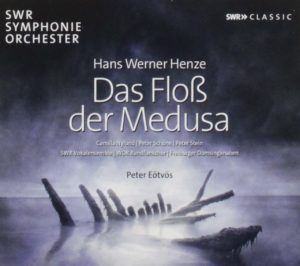 Two important additions to the legacy of the second most famous German composer of his generation. In the first, the late Oliver Knussen conducts the BBC Symphony Orchestra in several classic Henze works, including the first proper recording of his symphonic poem Heliogabalus Imperator, written in 1972, revised in 1986, and named for the brief and garish reign of an obscure 3rd century Roman Emperor. The music is appropriately raucous and colorful, more reminiscent of Messiaen than most Henze compositions. Meanwhile the ever-industrious Peter Eötvös conducts the first digital recording of Henze’s most notorious dramatic piece, The Raft of the Frigate Medusa. It’s also the first to incorporate the revisions that Henze made to the score in 1990, and it sounds great
Two important additions to the legacy of the second most famous German composer of his generation. In the first, the late Oliver Knussen conducts the BBC Symphony Orchestra in several classic Henze works, including the first proper recording of his symphonic poem Heliogabalus Imperator, written in 1972, revised in 1986, and named for the brief and garish reign of an obscure 3rd century Roman Emperor. The music is appropriately raucous and colorful, more reminiscent of Messiaen than most Henze compositions. Meanwhile the ever-industrious Peter Eötvös conducts the first digital recording of Henze’s most notorious dramatic piece, The Raft of the Frigate Medusa. It’s also the first to incorporate the revisions that Henze made to the score in 1990, and it sounds great - Richard Rodney Bennett: Orchestral Works, Vol. 3 (Spotify)
The latest in Chandos’ survey includes some of Bennett’s better-enduring works, such as the First Symphony and Zodiac (which is quite unlike Stockhausen’s namesake). The music is basically neoclassical, but in the modernist vein of middle Tippett - Stockhausen, Xenakis, Ferneyhough, Donatino, Reynolds, Fundal, Henze: 20th Century Percussion Solos (Spotify)
Fine new versions of evergreens Zyklus and Psappha from Danish percussionist Mathias Reumert, and a first recording of Roger Reynolds’ epic Watershed
Stage to video
Among the year’s video releases with particular significance to new music, three major European opera productions stand out. Not so much the Alex Ross vaunted trio of Heart Chamber, Orlando and The Snow Queen—simply because the first two have not been recorded while the third, though visually attractive and a vehicle for the justifiably glorified Barbara Hannigan, seems an overly ambitious foray into operatic spectacle for a composer whose authentic voice is fundamentally introverted and non-verbal. Instead I was more struck by the following thought-provoking productions that show how the creative standards for new music theater remain quite high.
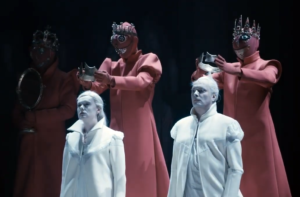
- Pascal Dusapin and Frédéric Boyer: Macbeth Underworld (YouTube)
I’ve had trouble warming to Dusapin’s coupling of a colorful but thick postmodernist idiom with conventional opera’s vocal and instrumental baggage, but Macbeth Underworld is one of his most successful efforts, depositing Shakespeare’s fallen couple into a hell-world informed by Dante and Elizabethan nostalgia. It was premiered at La Monnaie in September, and a fine video culled from two October performances has been published to YouTube for the rest of us to enjoy. An especially lovely touch is the bedroom duet in the second scene, where the increasingly insane couple is accompanied by a solo archlute (played by Christian Rivet). The comic Porter (played by British tenor Graham Clark) doubles as Hecate and serves as a recurring commenting fool, replete with red Bozo the Clown hair and frequently accompanied by an onstage fiddler - Francesco Filidei and Joël Pommerat: L’Inondation (ARTE)
A newer voice is the Italian composer Francesco Filidei (1973–). A pupil of Sciarrino and an organist by trade, his music is eclectic, with postminimalist passages culminating in hints of Vivier, and spectralist string harmonic glissandos accompanying discoordinated vocal melodies in a manner reminiscent of Saariaho. One might connect Filidei with the post-Henze variety of European neoclassicism that’s currently making a comeback. But regardless, the language is well-suited for the scenario, adapted by Joël Pommerat (who also directs this premiere production at the Opéra Comique) from the same Yevgeny Zamyatin short story that spawned the 1994 Franco-Russian film. The central character is an unnamed woman (played by the versatile young French singer Chloé Briot) in a childless and somewhat dysfunctional relationship. She strangles (or perhaps hallucinates that she strangles) the couple’s adopted teenage girl (represented onstage by two identically costumed and wigged women, one an actor, the other a singer). As in Wozzeck, the music represents the world as she perceives it, so although it’s clear that she is insane by the end of the opera, we can’t be sure how much of the action, perhaps including the titular flood itself, is real rather than imagined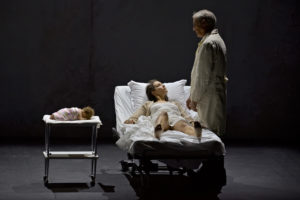
- Karlheinz Stockhausen: aus LICHT (ARTE)
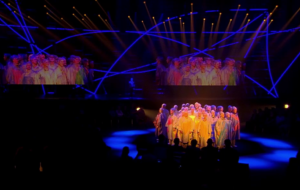 Finally there’s the aforementioned Kathinka Pasveer/Pierre Audi condensed production of LICHT. ARTE has made available a high-quality 90-minute video sampler featuring 16 excerpts from the 15-hour performance. These are intercut with shots of schoolchildren creating art projects based on the cycle’s Urantia Book-inspired story lines (Stockhausen Sonntagsschule, I guess). Not surprisingly, the excerpts feature the most visually striking passages (such as the Central African video sequence from Michael’s Ride Around the World) and the broad-stroked lighting and set design from Urs Schönebaum, with its curved illuminated piping, multiple video projection screens, and monochromatic blocks of color (chiefly red, blue and yellow). The last three excerpts come from Mittwoch and Sonntag, and feature passages not included in the IDAGIO audio album: a 6½ minute look at Orchester-Finalisten, 13 minutes of the notorious Helikopter-Streichquartett (performed by the Pelargos Quartet in feathery costumes) and the cathartic choral piece Engel-Prozessionen
Finally there’s the aforementioned Kathinka Pasveer/Pierre Audi condensed production of LICHT. ARTE has made available a high-quality 90-minute video sampler featuring 16 excerpts from the 15-hour performance. These are intercut with shots of schoolchildren creating art projects based on the cycle’s Urantia Book-inspired story lines (Stockhausen Sonntagsschule, I guess). Not surprisingly, the excerpts feature the most visually striking passages (such as the Central African video sequence from Michael’s Ride Around the World) and the broad-stroked lighting and set design from Urs Schönebaum, with its curved illuminated piping, multiple video projection screens, and monochromatic blocks of color (chiefly red, blue and yellow). The last three excerpts come from Mittwoch and Sonntag, and feature passages not included in the IDAGIO audio album: a 6½ minute look at Orchester-Finalisten, 13 minutes of the notorious Helikopter-Streichquartett (performed by the Pelargos Quartet in feathery costumes) and the cathartic choral piece Engel-Prozessionen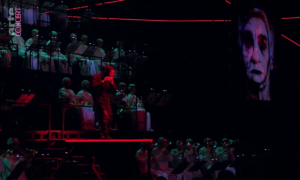
- From Elbphilharmonie, György Ligeti: Le Grand Macabre (YouTube) and HK Gruber: Frankenstein!! (YouTube)
If you don’t live near Hamburg and haven’t yet seen the interior of the spectacular new Elbphilharmonie, the next best thing is to watch Doug Fitch’s concert staging of Le Grand Macabre performed there by new arrival Alan Gilbert, who debuted the production in 2010 during his stint with the New York Philharmonic. Also worth viewing from the Elbphilharmonie is HK Gruber singing and conducting his song cycle Frankenstein!!, long a hit on Germanic concert stages. Also on the program are his Manhattan Broadcasts and Weill’s Second Symphony, the latter reminding us all where Gruber’s roots lie. Regrettably no English subtitles though - Robert Ashley: Improvement (Don Leaves Linda) (Vimeo)
From New York comes this revival of Robert Ashley’s new music theater piece from 1985–1991. Ashley called it an opera, placing it in the tetralogy that also includes Now Eleanor’s Idea, but it’s more in the lineage of Einstein on the Beach in its avoidance of opera singers and traditional instruments. The production from Tom Hamilton and David Moodey is unlikely to sway opinions about Ashley’s stage works in either direction, but it puts the material in the best possible light, and is a welcome addition to the paltry collection of professionally documented landmarks of American experimental theater
Past and present
Special mention goes to Agamemnon the opera, one of the most remarkable of the year’s Web-driven “back from oblivion” discoveries. It was conceived in the late 1980s as an opera on disk by Nicole Gagné and the late David Avidor. Gagné, who adapted the libretto from Aeschylus, is best known as a music writer (among other things she compiled the Historical Dictionary of Modern and Contemporary Classical Music), while Avidor seems to be mainly remembered as a recording engineer. Both are present as musicians for most of the opera’s two hours and five acts, but they’re joined by an astonishing cast loaded with such Downtown superstars as Fred Frith, Pauline Oliveros, Julius Eastman (who voices Agamemnon), Sussan Deyhim, Blue Gene Tyranny, Shelley Hirsch (who voices Cassandra), Robert Ashley, David Shea, Arto Lindsay (who plays Aegisthus) and Ned Sublette (whose Texas accent reminds me of The Residents’ Homer Flynn). Most of these artists contribute improvisationally to the musical texture.
Though the opera was completed in 1992, it was never released on a commercial recording (the contributing musicians didn’t even know it had been finished). So it lay forgotten for over two decades until a buzz began to circulate in social media this past year that the piece had been published on Bandcamp, to the delight of contemporary music fans intrigued by its lineup of unique musical personalities.
That this project from 30 years ago can be included here with no loss of continuity (apart from the presence of a few long-deceased voices) speaks to the stability (or stagnation if you want to be less charitable) of the current musical environment. The 2010s were not so much distinct from their predecessors as they were a prolongation of themes that have been dominant for quite some time in Western art music and its neighboring regions. One can reasonably claim (and many have) that no fundamentally new musical ideas have arisen since the 1970s spawned spectralism and hip hop. Subsequent innovations have been of the strictly recombinant variety (i.e., postminimalism and the kinds of intercultural fusion described above) or the reclamatory one (neoromanticism, the modular synth revival, etc.).
It might seem ironic that the age of globalism and the Internet has produced so much displacement in how music is mediated and commodified, yet so little evolution in its style. But if the effect of the last ontological revolution in Western art music—that of the post-WW2 avant-garde—was to expand the range of allowable musical material to include literally any reproducible sound, then it stands to reason that the only further room for radical change is in the epistemological direction. It’s too soon to see what particulars that next revolution will involve. The more doomsday-oriented observers, such as Richard Taruskin, suggest that the end of Western art music is already in sight as the supremacy of written music gets overrun by modern technology. But the quantity of visionary artists dedicated to moving the music forward—artists who regard all facets of its modern praxis, whether composed, improvised or fixed-media, as belonging to an integral shared tradition—is amply displayed by the compelling work showcased in this article. It suggests that this most progressive and unpredictable of musical traditions may still have some life left in it.
Photo credits: Sam Shalabi via Constellation Records, Lao Dan via Family Vineyard Records, Taylor Ho Bynum 9-tette via Bynum, Zeena Parkins by Andy Newcombe, Ellen Arkbro via the artist, Michael Pisaro by Kathy Pisaro (design Matthew Revert), Cecilia Lopez by Ian Kornfeld, Žibuoklė Martinaitytė by Lina Aiduke, Martin Bliggenstorfer by Michael Schell, Frank Zappa by Jay L. Handler, Pehr Henrik Nordgren via Kai Nordgren/Wikimedia, Magdalena Kožená and Georg Nigl in Dusapin: Macbeth Underworld via La Monnaie, L’Inondation by Stefan Brion/Opéra Comique, Agamemnon: Fred Frith by Alexander Kurz, Pauline Oliveros by Linda Montano, Shelley Hirsch by Frank Schindelbeck, Julius Eastman via Wikipedia, Arto Lindsay by Carstor, Sussan Deyhim by Robert Hayman, Robert Ashley by Savio.
